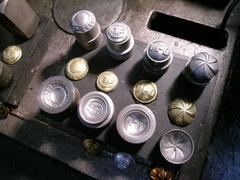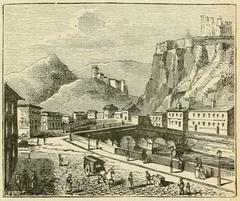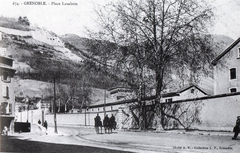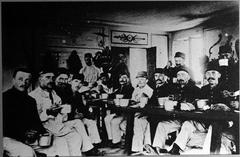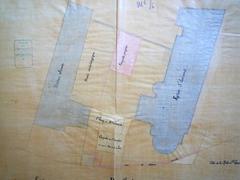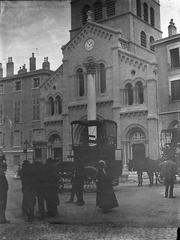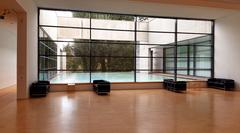
Temple De L’Église Réformée De Grenoble: Visiting Hours, Tickets, and Historical Significance
Date: 04/07/2025
Introduction
Nestled in the heart of Grenoble, France, the Temple de l’Église Réformée de Grenoble is both a striking architectural landmark and a vibrant center of Protestant heritage. This neoclassical rotunda stands as a testament to centuries of resilience, religious transformation, and civic engagement. As the principal place of worship for the United Protestant Church of France (Église Protestante Unie de France), the temple is not only a monument to the city’s Protestant past but also a dynamic community hub for worship, culture, and dialogue. This comprehensive guide provides detailed information on the temple’s history, architecture, visiting hours, ticketing, accessibility, and offers practical tips to enrich your experience at one of Grenoble’s most significant religious and cultural sites.
Table of Contents
- Historical Overview
- Architectural Design and Features
- Historical and Cultural Significance
- Visiting Information
- Community and Cultural Life
- Frequently Asked Questions (FAQ)
- Conclusion and Visitor Recommendations
- Sources
Historical Overview
Origins of the Reformed Church in France
The roots of the Temple de l’Église Réformée de Grenoble trace back to the 16th-century Protestant Reformation. Influenced by Martin Luther and, notably, Jean Calvin, the Reformed movement found fertile ground among French intellectuals and nobility. The first Reformed communities appeared around 1555, amid religious and political conflict (Musée Protestant). Despite severe persecution—including the Wars of Religion and the revocation of the Edict of Nantes in 1685—these communities persisted, often practicing their faith in secret. Legal recognition for Protestants was gradually restored following the Edict of Tolerance (1787) and the French Revolution, culminating in the 1802 Concordat.
Protestantism in Grenoble and the Dauphiné Region
Grenoble, situated in the Dauphiné, became a stronghold for Huguenots (French Protestants), particularly during times of persecution. The region’s mountainous terrain offered shelter, while the city itself evolved into an important center for Protestant worship and social activism. After the re-establishment of religious freedoms in the 19th century, the Protestant community flourished. The construction of the present temple in the 1830s marked a new era of public presence and civic participation for Grenoble’s Protestants (POP: Plateforme ouverte du patrimoine).
Modern Developments and Community Life
In 2013, the Reformed and Lutheran churches in France united to form the Église Protestante Unie de France (EPUdF), with the Grenoble congregation remaining one of the largest in the country (epudf.org). Today, the temple is a lively center for worship, education, outreach, and cultural events, reflecting the enduring legacy and adaptability of Protestantism in the region.
Architectural Design and Features
Central Rotunda and Neoclassical Elements
The Temple de l’Église Réformée de Grenoble is distinguished by its rare circular (rotunda) plan, measuring nearly 15 meters in diameter. This architectural choice fosters a sense of unity and equality among worshippers, echoing the Reformed emphasis on communal worship. The entrance is defined by a majestic Ionic portico, topped with a classical pediment and an entablature adorned with medallions and triglyphs—a nod to Enlightenment ideals and the dignity of public worship (POP: Plateforme ouverte du patrimoine).
The building’s original dome (no longer extant) would have provided a luminous, open space ideal for congregational singing and preaching, central to Reformed liturgy. The rotunda’s interior is characterized by plain wooden pews arranged in a circular fashion, drawing all eyes toward the pulpit and communion table.
Artistic and Decorative Highlights
While the temple’s design avoids excessive ornamentation, the medallions on the portico’s entablature and the careful proportions of the Ionic columns contribute to a refined, harmonious aesthetic. The interior features a historic organ, regularly used for services and concerts, enhancing both the acoustic and cultural life of the building. Modest stained-glass windows provide additional light and visual interest, often with simple biblical or abstract themes.
Historical and Cultural Significance
Designated as a Monument Historique in 1975, the temple is recognized for both its architectural uniqueness and its symbolic role in the history of religious tolerance in France (POP: Plateforme ouverte du patrimoine). The building’s prominent position in central Grenoble underscores the integration and visibility of the Protestant community within the city’s social and urban fabric. Beyond its historical value, the temple remains an active place of faith, dialogue, and civic engagement, contributing to Grenoble’s reputation for openness and cultural vitality.
Visiting Information
Location and Accessibility
The temple is centrally located and easily accessible by public transportation (tram and bus lines) and is within walking distance of Grenoble’s main train station. Public parking is available nearby, though many visitors prefer to explore the pedestrian-friendly city center on foot or by bicycle. The building is wheelchair accessible, with ramps and accessible seating; visitors with specific needs are encouraged to contact the temple in advance.
Opening Hours and Admission
- Visiting Hours: The temple is open to visitors during Sunday services (typically at 10:30 AM) and during special events or by appointment. Standard visiting hours are usually from Tuesday to Saturday, 10:00 am–12:00 pm and 2:00 pm–5:00 pm, but these may vary—always check the official website for up-to-date information.
- Admission: Entry is free; donations are welcomed to support the upkeep and community work of the temple.
Guided Tours and Special Events
Guided tours are available by prior arrangement and during events such as European Heritage Days. Tours highlight the temple’s history, architecture, and role in Grenoble’s religious life. The temple also hosts concerts, lectures, and community gatherings—check the events calendar on the official website.
Practical Visitor Tips
- Dress Code: Modest attire is recommended, especially during services.
- Photography: Permitted outside of worship services; please be respectful of worshippers and avoid flash or tripods.
- Language: Services and most events are in French, though some staff and parishioners may speak English.
- Quiet Reflection: The temple is a space for contemplation; maintain a respectful demeanor during your visit.
Community and Cultural Life
The temple is a cornerstone of Grenoble’s Protestant community, hosting regular worship, educational programs, concerts, and charitable initiatives. Its democratic governance structure encourages active participation from both clergy and lay members (Musée Protestant). The temple’s cultural programming, including frequent organ and choral concerts, attracts a diverse audience and strengthens its role as a bridge between faith and the arts (Petit Futé).
Frequently Asked Questions (FAQ)
Q: What are the current visiting hours?
A: The temple is open Tuesday to Saturday, 10:00 am–12:00 pm and 2:00 pm–5:00 pm, and during Sunday services at 10:30 am. Confirm current hours on the official website.
Q: Is there an entrance fee?
A: No, admission is free. Donations are appreciated.
Q: Are guided tours available?
A: Yes, by advance booking or during special events.
Q: Is the temple accessible for people with disabilities?
A: Yes, with ramps and accessible seating. Please contact the temple for specific needs.
Q: Can I take photographs inside?
A: Yes, but please avoid flash and respect worshippers.
Q: What else is nearby?
A: The Bastille fortress, Musée de Grenoble, and the Isère riverfront are all within walking distance (generationvoyage.fr).
Conclusion and Visitor Recommendations
The Temple de l’Église Réformée de Grenoble is more than a historical monument—it is a living center of worship, culture, and community engagement. Its neoclassical architecture, rich heritage, and ongoing cultural programming make it a must-visit for anyone exploring Grenoble’s historical sites. Whether you attend a concert, join a guided tour, or simply enjoy the peaceful ambiance, your visit will offer insight into the enduring spirit of France’s Protestant tradition.
For the latest visiting hours, event schedules, and guided tour information, consult the temple’s official website. Consider downloading the Audiala app for immersive audio guides and updates on cultural events.
Sources
- Musée Protestant: https://museeprotestant.org/en/notice/french-reformed-church/
- POP: Plateforme ouverte du patrimoine: https://pop.culture.gouv.fr/notice/merimee/PA00098977
- Generation Voyage: https://generationvoyage.fr/visiter-grenoble-faire-voir/
- Petit Futé: https://www.petitfute.com/v10838-tours-37000/c1172-pense-fute-services/c1134-religion/c1135-lieu-de-culte/c849-protestant/568481-temple-de-l-eglise-reformee.html
- Église Protestante Unie de France: https://epudf.org/
- Annuaire EPUdF: https://annuaire.epudf.org/


